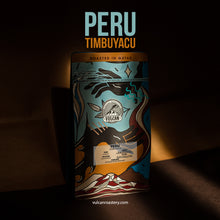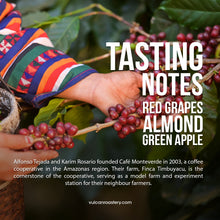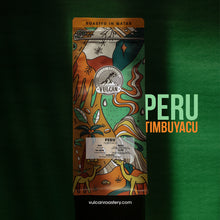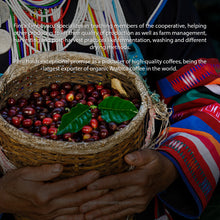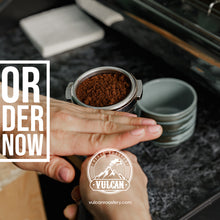
بيرو - تيمبوياكو
قام الثنائي الزوج والزوجة، ألفونسو تيجادا إيبيريكو وكريم روزاريو أراوز غرانديز، بتأسيس مقهى مونتيفيردي في عام 2003، وهي تعاونية للقهوة في منطقة الأمازون.
الصنف: بوربون، كاتيمور، كاتواي، كاتورا، ماراجوجيبي، باتشي
المعالجة: العسل اللاهوائي
الارتفاع: 1620 متر فوق مستوى سطح البحر
المنتج: ألفونسو تيجادا إيبيريكو وكريم روزاريو أراوز غرانديز
المنطقة: الأمازون
ملاحظات التذوق: العنب الأحمر، اللوز، التفاح الأخضر

تعتبر مزرعة تيمبوياكو حجر الأساس للتعاونية، حيث تعمل كمزرعة نموذجية ومحطة تجارب وأكثر من ذلك.
حول المنتجين
ورث ألفونسو تيخادا إيبيريكو مزرعة تيمبوياكو من والدته، التي ورثتها بدورها من والدتها، إليودورا موري دي إيبيريكو. كانت إليودورا مصدر إلهام لزوجته ألفونسو،
كريم روزاريو أراوز جرانديز. يأتي اسم المزرعة من قصة كانت إليودورا تحكيها لألفونسو عن نبع في المزرعة كان به الكثير من الماء، حتى أن الماء كان يتدفق من النبع وكأنه يغلي. يأتي اسم تيمبوياكو من كلمتي تيمبو التي تعني الغليان وياكو التي تعني الماء بلغة الكيتشا. من أجل مواصلة إرث جدته،
بدأ ألفونسو وكريم مشروعهما "الأمل الجديد" في عام 2010 عندما باعا وكالة السفر التي كانا يمتلكانها في ليما من أجل العودة إلى مزرعة تيمبوياكو وإنشاء مزرعة نموذجية. وتحت رعايتهما، أصبحت مزرعة تيمبوياكو قلب جهود مقهى مونتيفردي. وكان الزوجان ملتزمين بتحسين الظروف الاجتماعية للمنتجين الصغار الآخرين في المنطقة، وكانا يتصوران أن هذا العمل هو وسيلة لمساعدة المنتجين في المنطقة على تسويق قهوتهم في ظروف أفضل.
ولعل أهم ما يميز مزرعة تيمبوياكو هو دورها كمزرعة نموذجية. ويمكن للأعضاء زيارتها للتعرف على إدارة المزرعة والحصاد وكذلك ممارسات ما بعد الحصاد مثل التخمير والغسيل وطرق التجفيف المختلفة. وتتخصص مزرعة تيمبوياكو في تعليم الأعضاء مجموعة متنوعة من المهارات التي من شأنها رفع جودة إنتاجهم إلى أعلى المستويات الممكنة.
زراعة
عندما زرعوا أشجار البن لأول مرة في تيمبوياكو، أخبرهم الجميع أنه لن ينمو شيء. وحذروهم من أن الأرض ليست خصبة وأن محصولهم لن يكون كبيرًا أبدًا. ومع ذلك، وبفضل رعايتهم الدقيقة، زاد محصولهم وجودة البن كل عام. احتلت قهوة تيمبوياكو المركز الثاني عشر في كأس التميز لعام 2017.
من بين 68 هكتارًا من مزرعة تيمبوياكو، هناك 38 هكتارًا مخصصة لمحميات الغابات التي تحمي النباتات المحلية وأنواع الحياة البرية. كما تحمي مناطق المحميات بحيرة المزرعة والمجرى الطبيعي من خلال توفير حاجز طبيعي لإبطاء التآكل ومنع التلوث.
كانت جدة ألفونسو، إليودورا، تزرع القهوة واليوكا والذرة والموز وقصب السكر والأناناس والفاصوليا وأشجار الفاكهة الأخرى المتنوعة على الأرض. وكانت تقيم أكوامًا حجرية (بيلانكون) لتحديد التقسيمات بين المحاصيل. ولا تزال هذه الأكوام الحجرية جزءًا من
منظر المزرعة اليوم. قبل وفاتها، وزعت إليودورا الأرض بين أطفالها، بما في ذلك والدة ألفونسو. اليوم، يزرع ألفونسو وكريم أيضًا اليوكا والموز والفاصوليا والخضروات والبرتقال والأناناس.

الحصاد وما بعد الحصاد
يتم قطف الكرز يدويًا بشكل انتقائي ثم وضعه في حاويات محكمة الغلق حيث يتخمر بشكل لاهوائي لمدة 18 ساعة. بعد ذلك، يتم تقشير الكرز ووضعه في أكياس Ecotact للتخمر بشكل لاهوائي لمدة 24 ساعة.
ثم يتم وضع الرق والصمغ المتبقي في طبقات رقيقة على أسرة التجفيف والشرفات. ويتم تقليب القهوة بشكل متكرر لضمان التجفيف المتساوي.
نبذة عن مقهى مونتيفردي
ينشئ مقهى مونتيفردي علاقات مع مجموعة واسعة من المنتجين ومنظمات المنتجين. بالإضافة إلى إنتاج مجموعة من مزارعهم الصغيرة من Finca Timbuyacu، يركز ألفونسو وكريم على تقديم مجموعة من الخدمات لأعضاء المنتجين والمساعدة في تسويق قهوتهم. يساعد مونتيفردي مزارع الأعضاء على اتخاذ خطوات لضمان إدارة التربة والحفاظ عليها بشكل جيد.
ويقوم الأعضاء بزراعة حواجز حية وأشجار ظليلة متنوعة، وإضافة خطوط محيطية للحد من التآكل. كما تلعب آراوز وتيخادا دورًا نشطًا في مجتمعات منتجيهما. في عام 2010، قامت المنظمة بشكل جماعي بشراء ملعب للأطفال في أحد مجتمعات المنتجين. ثم في عام 2014، اشترت 40 مرتبة جديدة للأطفال الذين كانت ظروف نومهم دون المستوى.
منذ تأسيسها، عملت شركة مونتيفردي على إقامة علاقات مع مجموعة واسعة من المنتجين ومنظمات المنتجين. بالإضافة إلى إنتاج مجموعة من القطع الصغيرة الخاصة بها من Finca Timbuyacu، تقوم التعاونية أيضًا بتسويق القطع الجماعية وتوفير مجموعة من الخدمات للمنتجين الذين تعمل معهم. تساعد مونتيفردي المزارع الأعضاء على اتخاذ خطوات لضمان إدارة التربة والحفاظ عليها بشكل جيد.
ويقوم الأعضاء بزراعة حواجز حية وأشجار ظليلة متنوعة وإضافة خطوط محيطية للحد من التآكل. كما تلعب آراوز وتيخادا دورًا نشطًا في مجتمعات منتجيهما. في عام 2010، قامت المنظمة بشكل جماعي بشراء ملعب للأطفال في أحد مجتمعات المنتجين. ثم في عام 2014، اشترت 40 مرتبة جديدة للأطفال الذين كانت ظروف نومهم دون المستوى.

القهوة في بيرو
تتمتع بيرو بإمكانات استثنائية كمنتج للقهوة عالية الجودة. تعد البلاد أكبر مصدر للقهوة العربية العضوية على مستوى العالم. وبفضل ارتفاعاتها الشاهقة وتربتها الخصبة، ينتج المزارعون الصغار في البلاد أيضًا بعض أنواع القهوة المميزة المذهلة.
على الرغم من وصول القهوة إلى بيرو في القرن الثامن عشر، إلا أن تصدير القهوة كان محدودًا للغاية حتى أواخر القرن التاسع عشر. وحتى تلك النقطة، كان معظم القهوة المنتجة في بيرو يُستهلك محليًا. وعندما ضرب صدأ أوراق القهوة إندونيسيا في أواخر القرن التاسع عشر، وهي دولة مركزية في زراعة القهوة الأوروبية،
ومع انخفاض الواردات في ذلك الوقت، بدأ الأوروبيون في البحث في أماكن أخرى عن حل لمشاكلهم. وكانت بيرو خيارًا مثاليًا.
بين أواخر القرن التاسع عشر والحرب العالمية الأولى، استثمرت المصالح الأوروبية موارد كبيرة في إنتاج البن في بيرو. ومع ذلك، مع ظهور الحربين العالميتين، ضعفت إنجلترا والقوى الأوروبية الأخرى واتخذت منظورًا أقل استعمارية. عندما غادر البريطانيون وأصحاب الأراضي الأوروبيون الآخرون، اشترت الحكومة أراضيهم وأعادت توزيعها على السكان المحليين.
أعادت الحكومة البيروفية شراء مليوني هكتار كانت قد مُنِحَت لإنجلترا في السابق، ووزعت الأراضي على آلاف المزارعين المحليين. وقد قام العديد من هؤلاء المزارعين فيما بعد بزراعة القهوة على الأراضي التي حصلوا عليها.
اليوم، يعتمد مزارعو البن البيروفيون بشكل كبير على مزارع صغيرة الحجم. وعادة ما يقوم المزارعون في بيرو بمعالجة البن في مزارعهم الخاصة. ويتم غسل معظم البن بالكامل. وعادة ما يتم تقشير الكرز وتخميره وتجفيفه في الشمس على أسِرّة مرتفعة أو حظائر تجفيف.
أصبحت البيوت الزجاجية المجففة والأسرّة المكافئة أكثر شيوعًا مع تحول المزارعين نحو الأسواق المتخصصة. بعد التجفيف، يتم بيع القهوة في ورق البرشمان إلى التعاونية. عادةً ما يبيع المنتجون غير الأعضاء في التعاونية إلى وسيط.
إن العضوية التعاونية تحمي المزارعين بشكل كبير من الاستغلال ويمكن أن تحدث فرقًا كبيرًا في الدخل من القهوة. ومع ذلك، فإن حوالي 15-25% فقط من صغار المزارعين ينضمون حاليًا إلى مجموعة تعاونية.






